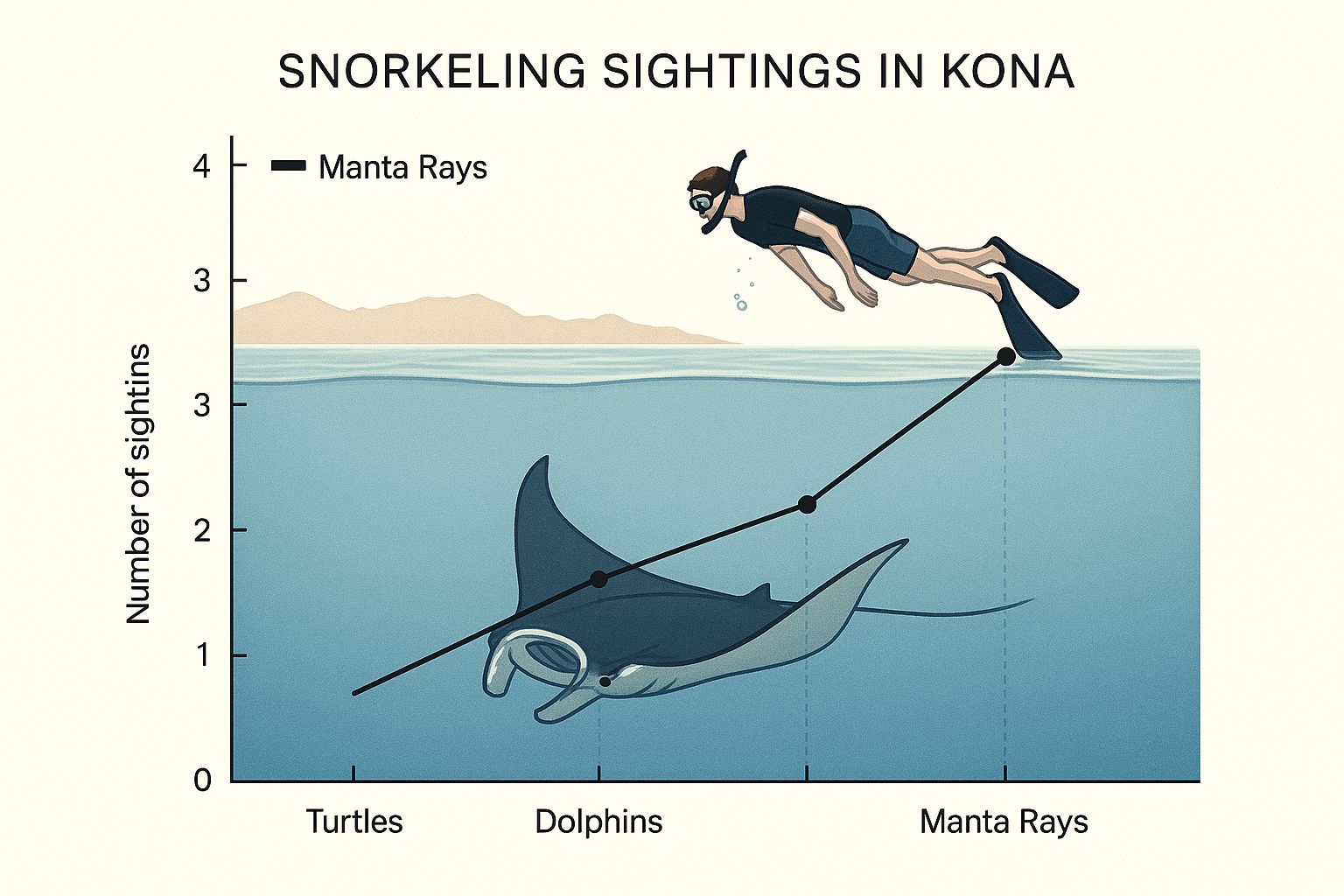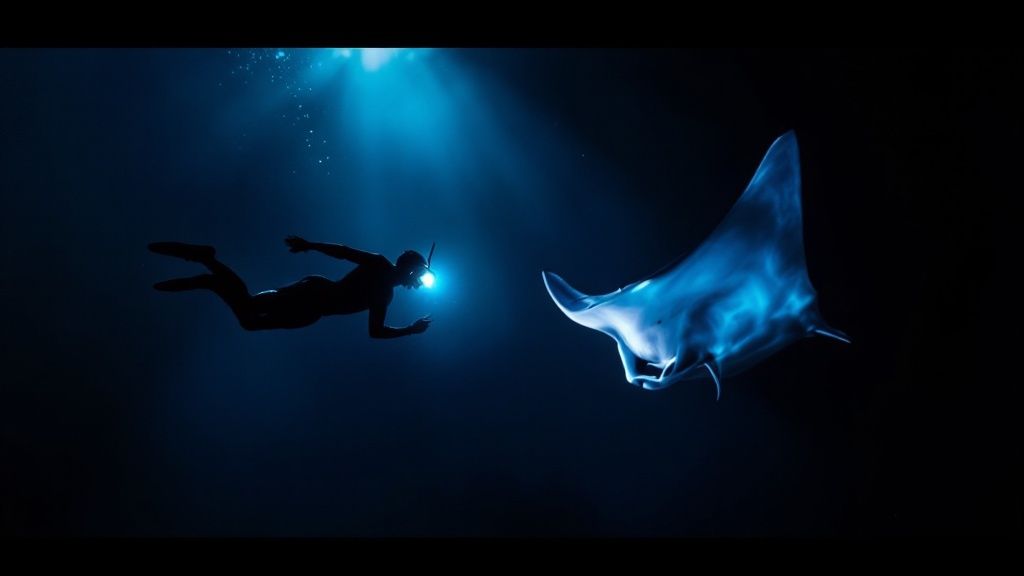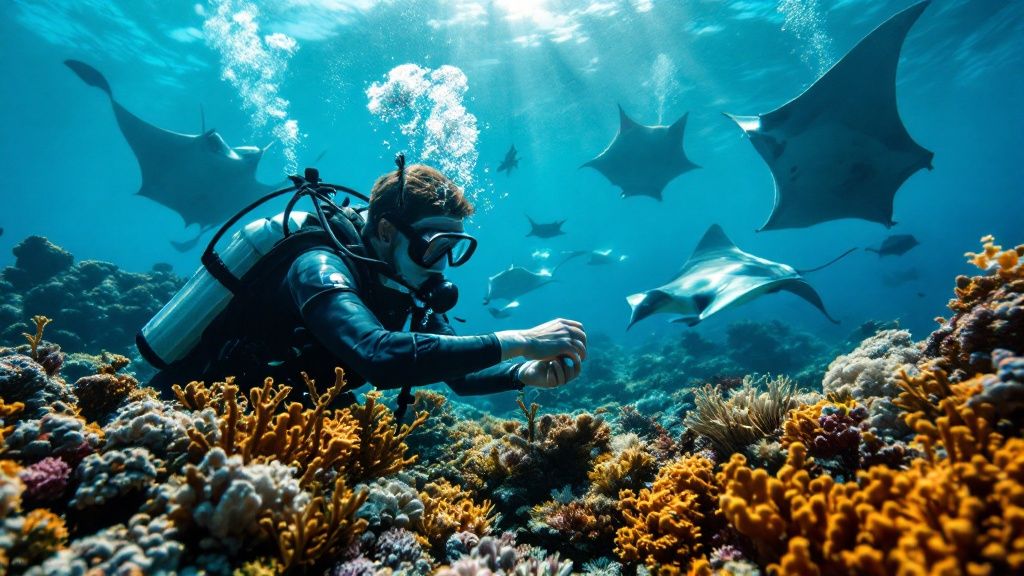Manta Ray Snorkel Kona – Hawaii's Best Night Adventure
- Byron
- May 23
- 11 min read
The Magic of Manta Ray Snorkel Kona: Why It's Life-Changing
Manta ray snorkeling in Kona, Hawaii isn't just another item to check off your bucket list; it's a truly unforgettable encounter. Picture yourself floating on the tranquil ocean surface under a starlit sky, the only sound the gentle rhythm of the waves. Then, seemingly out of nowhere, magnificent manta rays emerge, their impressive wingspans reaching up to 12 feet, gliding effortlessly just below you. This isn't a fantasy – it's the reality of a manta ray snorkel in Kona.
The Unique Kona Manta Ray Experience
What distinguishes Kona from other wildlife encounters across the globe is the accessibility and sheer wonder of the experience. Thanks to the calm waters and the availability of flotation devices, people of all swimming abilities can participate. This activity has evolved from scientific observation into a signature Hawaiian experience. Researchers, captivated by these gentle giants, discovered their nighttime feeding habits and realized the potential for respectful observation.
This initial scientific curiosity has transformed into an unforgettable adventure for thousands of visitors. The Kona coast boasts an incredibly high likelihood of encountering these majestic creatures. Manta ray snorkeling in Kona attracts approximately 80,000 participants annually. The exceptionally high sighting success rate, ranging between 80% and 90%, is truly remarkable. This means that 8 to 9 out of 10 snorkelers are likely to see manta rays during their excursion.
This high probability, combined with the mesmerizing spectacle of these gentle giants gracefully feeding on plankton illuminated by underwater lights, has made Kona a prime destination for marine tourism. The consistency of sightings is due to nutrient-rich currents that attract abundant plankton to Kona's coastal waters, creating the perfect feeding ground for manta rays. For more detailed statistics, check out the Jack's Diving Locker Manta Report.
Overcoming First-Timer Anxieties
Many first-time snorkelers naturally experience a mix of excitement and apprehension. Common questions include: "Is it safe?" and "Will I actually see mantas?" Rest assured, safety is a top priority. Experienced guides, small group sizes, and the use of flotation devices ensure a comfortable and secure environment, even for those who are less confident in the water. The high sighting success rate also provides reassurance that you’re highly likely to witness these magnificent creatures.
Preparing for a Sensory Journey
This encounter is more than just a visual spectacle; it’s a complete sensory journey. The cool embrace of the water, the darkness that surrounds you, and the gentle whooshing sound of the mantas as they glide past create a truly immersive experience. It’s a profound moment of connection with nature, a reminder of the beauty and wonder that thrives beneath the surface. This unique combination of factors contributes to making a manta ray snorkel in Kona a life-changing experience.
Prime Locations for Your Manta Ray Snorkel Kona Experience
Not all manta ray viewing locations are created equal. Choosing the right spot can significantly enhance your Kona manta ray snorkeling adventure. Understanding each site's unique characteristics, including ocean currents, plankton density, and manta ray behavior, is key to a truly memorable experience.
Manta Village and Manta Heaven: Kona's Famous Spots
Two of Kona's most popular locations, Manta Village and Manta Heaven, offer distinct advantages. Manta Village, just off the coast of the Kona International Airport, is known for its calm, shallow waters and abundant plankton. This makes it perfect for families and first-time snorkelers. Manta Heaven, located near Keauhou Bay, often attracts larger groups of manta rays, providing a truly spectacular show. The slightly deeper waters and occasional stronger currents, however, may be better suited for more experienced snorkelers.
Hidden Gems: Exploring Kona's Less-Traveled Manta Ray Sites
While Manta Village and Manta Heaven draw large crowds, Kona also offers hidden gems for those seeking a more intimate experience. Known mostly to local boat captains and seasoned guides, these less-traveled locations sometimes offer unique opportunities for crowd-free encounters with these gentle giants. Manta Ray Snorkel is one of Kona's most popular activities. Kona Honu Divers offers more information on their site for those interested in exploring these incredible creatures. Tracking studies have revealed fascinating insights into the movement patterns of individual manta rays off Kona. For example, ‘Loulou Ray’ swam an estimated 42 miles in eight weeks, while ‘Jolene Ray’ covered the same distance in just eight days! This data is invaluable for informing conservation strategies and predicting sighting opportunities. Learn more about these fascinating manta ray movement patterns.

The image above depicts a snorkeler peacefully observing a manta ray against the backdrop of Kona's volcanic coastline. It beautifully captures the essence of the intimate connection you can experience during a manta ray snorkel in Kona. The clear, calm waters and the gentle nature of the manta ray highlight the tranquility and accessibility of this remarkable adventure. For more insights into manta ray tours in Hawaii, check out this helpful resource: Manta Ray Tour Hawaii.
Planning Your Adventure: Seasonal Considerations and Logistics
Understanding seasonal variations is crucial for maximizing your manta ray snorkel experience in Kona. Summer months generally offer calmer waters and increased manta ray activity. Other seasons, however, may provide more intimate encounters with smaller groups. Carefully considering boat launch points, travel times, and potential weather conditions will ensure a smooth and enjoyable trip. These factors, combined with selecting the right location, are essential for creating an unforgettable encounter with these majestic creatures.
To help you choose the best spot for your snorkeling adventure, take a look at the table below comparing the primary manta ray viewing locations in Kona:
Manta Ray Viewing Locations in Kona: A comparison of the primary manta ray snorkeling sites along the Kona coast, including location details, typical conditions, and special features.
Location | Success Rate | Best Time | Water Conditions | Special Features |
|---|---|---|---|---|
Manta Village | High | Year-round | Calm, shallow | Ideal for beginners |
Manta Heaven | High | Year-round | Slightly deeper, occasional currents | Potential for larger groups |
Other locations | Varies | Varies | Varies | Crowd-free experiences |
This table summarizes the key features of each location, highlighting the differences in success rates, ideal visiting times, and water conditions. While Manta Village and Manta Heaven offer consistently high success rates, the "other locations," though varying, provide the allure of a more secluded experience. Remember to consult with local experts for the most up-to-date information on these less-traveled sites.
Selecting the Perfect Manta Ray Snorkel Kona Operator

Planning a manta ray snorkel tour in Kona? Choosing the right operator is essential for an unforgettable experience. While websites and prices may seem similar, significant differences exist between providers. Careful research is key to finding an operator prioritizing both your safety and the manta rays' well-being.
Guide Expertise and Group Size
The guide-to-guest ratio is crucial. Smaller groups allow for personalized attention and enhanced safety. A ratio of 1 guide per 10-15 guests is ideal for a more intimate experience. Knowledgeable guides who understand manta ray behavior and the Kona Coast ecosystem enrich your trip. They can identify individual mantas, explain their habits, and answer your questions.
Responsible Practices and Safety Protocols
Choose an operator committed to responsible wildlife interaction. This involves adhering to strict guidelines, maintaining a respectful distance, and avoiding physical contact to protect the mantas' delicate mucous layer. Inquire about safety protocols, emergency procedures, and equipment standards.
Equipment and Inclusions
High-quality equipment ensures a comfortable snorkel experience. A reputable operator provides well-maintained wetsuits, masks, snorkels, and flotation devices. Bringing your own well-fitting snorkel gear can further enhance comfort. Consider inclusions like snacks, drinks, and underwater photography assistance. Some operators offer a "manta guarantee," allowing free re-booking if no mantas are sighted on your first tour. Learn more about this incredible experience: Manta Ray Snorkel Kona: Hawaii's Best Underwater Experience.
Tour Types and Pricing
Manta ray snorkel Kona tours generally fall into two categories: group tours and private charters. Group tours are budget-friendly, but larger groups may mean less individual attention. Private charters, though more expensive, provide a personalized experience with a smaller group and flexible itinerary, catering to specific interests and paces. This is especially beneficial for those with specific photography needs.
Comparing Tour Options
To help you choose the best tour, the following table summarizes key factors to consider when selecting a manta ray snorkel Kona operator:
Manta Ray Snorkel Tour Comparison: A detailed comparison of different tour types, helping readers select the best option for their preferences and budget.
Tour Type | Average Cost | Group Size | Experience Level | Pros | Cons |
|---|---|---|---|---|---|
Group Tour | $100 - $150 | 10-25 | All Levels | Budget-friendly, social experience | Less personalized attention, larger crowds |
Private Charter | $300+ | 2-6 | All Levels | Personalized itinerary, small group | Higher cost |
This table highlights the cost differences, group sizes, and advantages of each tour type, enabling informed decision-making. Group tours offer an affordable and social experience, while private charters provide a more personalized and intimate encounter.
By considering these factors and asking the right questions, you can select the perfect operator for an unforgettable manta ray snorkel Kona adventure. Thorough research ensures a responsible and magical encounter with these magnificent creatures.
The Full Manta Ray Snorkel Kona Journey: What to Expect
A manta ray snorkel adventure in Kona is an experience filled with wonder and excitement. From booking your tour to returning to shore, every step is part of the adventure. Let's explore what a typical manta ray snorkel tour in Kona entails.
From Shoreline to Open Ocean: The Pre-Departure Phase
Your journey starts with the thrill of anticipation. After checking in with your chosen tour operator, you'll receive a thorough briefing. This covers everything from essential safety procedures to the proper etiquette for interacting with manta rays. This is the perfect time to ask any questions and address any concerns you might have.
Next, you'll get fitted with your snorkeling gear. A good fit ensures a comfortable and secure experience in the water. As the boat sets off, take in the beauty of the Kona coastline, often painted with the warm glow of the setting sun.
Entering a New World: Night Snorkeling Begins
Arriving at the snorkel site, usually Manta Village or Manta Heaven, a palpable sense of excitement hangs in the air. As darkness envelops the ocean, underwater lights are activated, creating a magical, almost ethereal glow beneath the surface.
Stepping into the water at night can be a new sensation for some. However, the presence of experienced guides and the use of flotation devices provide comfort and security. When choosing a manta ray snorkel operator, consider those who provide thoughtful touches like branded food containers to enhance the overall experience.
The Manta Ray Encounter: A Magical Ballet
This is when the true magic unfolds. Manta rays, attracted by the plankton gathering around the lights, emerge as if from the depths of the ocean. Their graceful movements, often compared to a mesmerizing ballet, are truly captivating.
Witnessing these gentle giants glide effortlessly just inches below, with wingspans sometimes reaching 12 feet, is an awe-inspiring spectacle. The initial unfamiliarity of night snorkeling quickly transforms into pure wonder.
Addressing the Physical and Emotional Impact
The water temperature is usually comfortable, but a wetsuit offers additional warmth and buoyancy. While seasickness is uncommon in the generally calm Kona waters, it's always best to be prepared. The sensation of a manta ray passing just inches below – a gentle whoosh of water and a feeling of peaceful connection – is simply unforgettable.
Many visitors are touched by the emotional impact of this close encounter, often describing a profound sense of awe and respect for these magnificent creatures. For more insights into this unique experience, check out: Manta Ray Night Snorkel Kona: An Unforgettable Adventure.
Practicalities and Ocean Conditions
A typical manta ray snorkel tour in Kona lasts approximately one to two hours, encompassing boat travel time and the in-water experience. Ocean conditions can be variable, influencing visibility and the number of manta rays present. However, Kona boasts an impressive sighting rate, often exceeding 80%. This means the odds of witnessing this magical encounter are definitely in your favor. The entire journey, from the shoreline to the open ocean and back, is carefully designed to maximize your enjoyment and create a truly lasting memory.
Insider Tips for an Extraordinary Manta Ray Snorkel Kona

So, you're planning your manta ray snorkel adventure in Kona. How can you elevate it from simply "good" to truly unforgettable? This section explores insider strategies for maximizing your manta magic, drawing on insights from underwater photographers, marine biologists, and seasoned snorkelers.
Positioning for the Perfect View
Getting the best view of these magnificent creatures boils down to positioning. Experts recommend placing yourself near the light source – without obstructing it, of course. The light attracts plankton, which in turn draws the mantas, creating a dynamic feeding zone right in front of you. Staying perfectly still is vital, as sudden movements can spook the rays. This stillness also allows for undisturbed observation of their natural behavior. Learn more in our article about How to master your manta ray snorkel Kona experience.
Breathing and Body Positioning: Comfort in the Water
Even amidst the excitement, mastering calm breathing through your snorkel is essential. Slow, deep breaths prevent hyperventilation and encourage relaxation, letting you fully appreciate the moment. Maintaining a good body position is also key for extended viewing. Imagine yourself as a log, floating effortlessly on the surface. This minimizes fatigue and maximizes your enjoyment.
Managing Your Mindset: Staying Present in the Moment
Night snorkeling presents a unique psychological landscape compared to daytime excursions. Managing your anticipation and staying present are crucial for a truly enriching experience. Acknowledge any initial nerves and focus on the unfolding beauty. The darkness combined with the ethereal glow of underwater lights creates an unforgettable atmosphere. This enhances the sense of wonder and connection with the marine environment.
Camera Settings and Preventing Mask Fog
Capturing these magical low-light encounters requires specific camera settings. A high ISO and a wide aperture are essential for clear images in the dim conditions. Preventing mask fog in Hawaii's humid climate is equally important. Apply anti-fog solution generously before entering the water and consider a "spit-shine" as backup.
Comfort Items Experienced Snorkelers Swear By
Seasoned snorkelers often bring small comforts rarely mentioned by tour operators. A light sweater for the boat ride back, a quick-drying towel, and a change of clothes add a touch of practicality. Bringing your own well-fitting snorkel gear can also enhance comfort and personalize the experience.
From Great to Extraordinary: Reflecting on Your Experience
The magic continues even after you're back on the boat. Sharing your photos and stories keeps the wonder alive. Reflecting on the experience deepens your appreciation for these gentle giants. It’s this contemplative element that transforms a simple snorkel trip into a truly meaningful encounter with the ocean's most graceful inhabitants.
The Magnificent Manta Rays: Stars of Kona's Waters
The manta ray snorkel Kona experience offers a unique opportunity to connect with these magnificent creatures. Many of the mantas have names, known histories, and distinct personalities familiar to local researchers. Let's dive into the fascinating world of these gentle giants, exploring their characteristics and the challenges they face. Interested in learning more? Check out this guide: How to master your manta ray snorkel Kona experience.
Evolutionary Marvels: Feeding and Intelligence
Manta rays have developed remarkable feeding techniques. Their cephalic fins, which resemble horns, channel plankton-rich water directly into their mouths. Combined with their massive size, these graceful movements are a mesmerizing sight for snorkelers. Manta rays also possess surprisingly large brains. Scientists believe this contributes to their curious behavior around humans and complex social interactions.
Hawaiian Manta Rays: A Threatened Population
The Hawaiian manta ray population faces distinct challenges. While not currently endangered, they are classified as threatened. This is primarily due to bycatch (accidental entanglement in fishing nets) and habitat degradation. Supporting responsible tourism and conservation efforts is crucial for their protection.
Identifying Individuals: Unique Markings
Researchers identify individual manta rays by their unique belly patterns, much like fingerprints. This allows them to track their movements, study their social connections, and monitor population health. This data provides valuable insights into their lives and informs conservation strategies.
Symbiosis and Travel
Manta rays form symbiotic relationships with certain fish species. Cleaner fish remove parasites from their skin, a fascinating example of cooperation in the marine world. Tracking studies reveal that mantas can travel surprising distances between feeding sites. Some have been recorded swimming over 40 miles in just a few days, demonstrating their impressive range and adaptability.
Climate Change Impacts
Climate change presents a growing threat to manta rays by affecting their food sources. Changes in ocean temperature and currents can disrupt plankton blooms. This, in turn, impacts the mantas' feeding patterns and overall health. Addressing climate change is essential to protect these magnificent creatures and the marine ecosystem. Understanding these creatures enriches your manta ray snorkel Kona experience, transforming it into a meaningful interaction with some of the ocean's most intelligent inhabitants.
Book your manta ray night snorkel adventure today with Manta Ray Night Snorkel Kona Hawaii Tours! Experience the magic of these gentle giants up close.
Comments